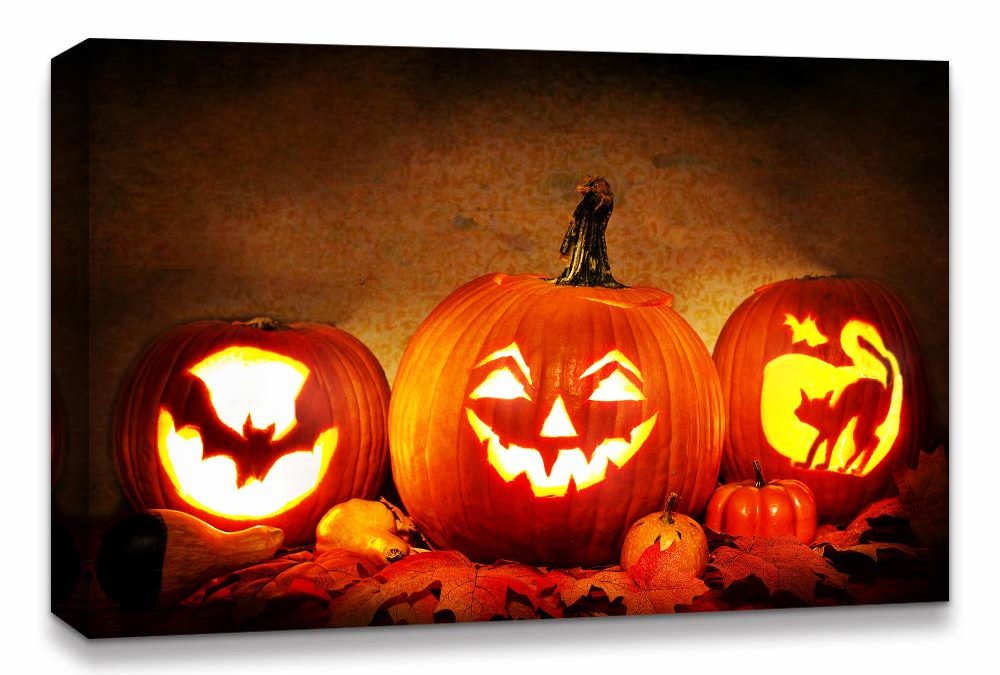September is here, and it won’t be long until fall has officially arrived! Is there anything more symbolic of fall than the bright, orange pumpkin? Seeing these show up at the local supermarket or adorning the porches of neighbors truly marks the transition from the summer months to the crisp autumn season. Pumpkins work perfectly as the symbol for winter, Halloween and Thanksgiving too! That said, how much do you really know about pumpkins? You may like looking at them. You may even like eating them prepared a variety of ways. That said, there’s no harm in knowing even more about them! Interested in learning more about them? Read below for some interesting pumpkin wall art facts.
Name & Bees
- Wondering where the word pumpkin comes from. The English word “pumpkin” can trace its origins back to the ancient Greek word “pepon,” which directly translates to “large melon.” Pumpkins are indeed both large and round, making the visual connection the melons rather obvious. “Pepon” was adopted by the French to describe the pumpkin, with them altering the word to “pompon.” The British later changed “pompon” to “pumpion.” Even later, American colonists changed “pumpion” to the word we know today as pumpkin.
- We don’t normally think of them as such, but pumpkins are also flowering produce. Like most flowering produce, pumpkins need the assistance of bees to transfer pollen to help with fertilization. Typically, large bees such as squash bees and eastern bumblebees fertilize pumpkins the most because they’re big enough to carry large pumpkin pollen particles. Due to the declining populations of squash bees, many pumpkin farmers now need to use honey bees in order to pollinate their crops. Read below for more pumpkin wall art facts.
Fruit & Berries
- Imagine you have just discovered pumpkins. Looking at one, which would you categorize it as? Fruit or vegetable? If you didn’t know before, pumpkins aren’t vegetables! They’re actually fruit. Surprised? We were! Pumpkins are much like tomatoes, eggplants and cucumbers in how deceiving they are! In the culinary world, many people treat pumpkins as vegetables and mainly prepare them in savory dishes. Pumpkins are as naturally sweet as most fruits, which is why this preparation is often favored. If you’re wondering why pumpkins are fruits, from a botanical perspective, it’s because pumpkins bear the seeds of the plant within.
- To add on to the fact that pumpkins are fruit, there’s a fact about them that makes them even stranger! Did you know that pumpkins are actually classified as being berries? The English language defines berry as a small, pulpy fruit. That said, this descriptor is not accurate from the perspective of a botanist. In botany, berries are fleshy fruits that develop from a single flower with just one ovary. Due to this botanic definition, tomatoes, eggplants, watermelons, and even pumpkins can all be defined as berries. Read below for more pumpkin wall art facts.
Lanterns & Eyes

- Is there imagery more representative of the Halloween holiday that a candlelit jack-o’-lantern? The tradition of the lantern can be traced back to Celtic celebrations within Scotland and certain parts of Ireland. The lantern originates from the Irish legend of Stingy Jack, a trickster damned to roam the Earth with only embers in a lantern to help guide his way. Originally, jack-o’-lanterns weren’t even made with pumpkins! Did you know that long ago, they were usually made with a combination of turnips and beets? When colonists arrived in America, they created the tradition of using pumpkins for jack-o’-lanterns? Why? Well, they were abundant in nature and much easier to carve due to their wide surface area.
- Many natural fruits and vegetables are good for the body. Pumpkin is no different! Aside from being delicious and versatile in preparation, pumpkins are also great for the eyes and for overall health! Pumpkins get their special, bright orange color from carotenoid pigments which can also be found in carrots. They’re also very rich in antioxidants like lutein and zeaxanthin which can help protect your tissues against damage from oxidization. Read below for more pumpkin wall art facts.
Seeds & States

- Much like how pumpkins rely on bees for fertilization, they also used to rely on large mammal for seed dispersal. Certain fruits and vegetables can only be carried from place to place through moving on the fur, or under the feet of certain animals. Pumpkins used to depend on mammoths and mastodons thousands of years ago. In this case, pumpkin seeds were spread from animal droppings. Mammoths would eat pumpkin fruit, then disperse seeds through their droppings during their pilgrimages. The oldest seeds that have been discovered within fossilized droppings are around 30,000 years old. Scientists believe that if humans had not discovered agriculture, it’s very likely that pumpkins would have gone extinct following the extinction of mammoths.
- Are you interested in knowing where the majority of pumpkins come from within the United States. Illinois outproduces every state when it comes to pumpkins. Did you know that Illinois actually produces 95% of the United States’ pumpkin crops every year? We hope you enjoyed these pumpkin wall art facts!
Conclusion
Pumpkins, the eternal symbols of autumn. How do you like your pumpkins? Made into pumpkin pie? How about drizzled with olive oil and roasted in the oven? Maybe you just prefer common pumpkin spices thrown into a caffeinated beverage? Or maybe you don’t eat pumpkins at all, and prefer to sit them on your porch as jack-o’-lanterns? No matter how you prefer your pumpkins, we’re glad you read this blog! Thanks for reading these pumpkin wall art facts!



